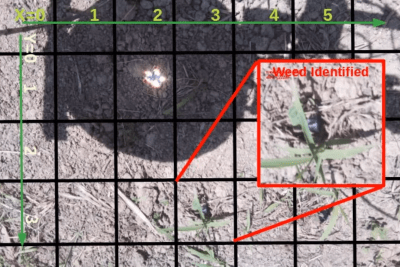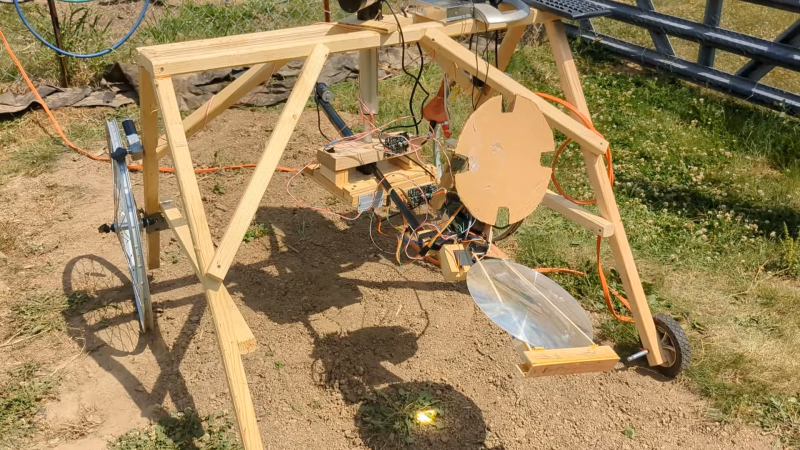Removing weeds is a chore few gardeners enjoy, as it typically involves long sessions of kneeling in the dirt and digging around for anything you don’t remember planting. Herbicides also work, but spraying poison all over your garden comes with its own problems. Luckily, there’s now a third option: [NathanBuildsDIY] designed and built a robot to help him get rid of unwanted plants without getting his hands dirty.
Constructed mostly from scrap pieces of wood and riding on a pair of old bicycle wheels, the robot has a pretty low-tech look to it. But it is in fact a very advanced piece of engineering that uses multiple sensors and actuators while running on a sophisticated software platform. The heart of the system is a Raspberry Pi, which drives a pair of DC motors to move the whole system along [Nathan]’s garden while scanning the ground below through a camera.
 The Pi runs the camera’s pictures through a TensorFlow Lite model that can identify weeds. [Nathan] built this model himself by taking hundreds of pictures of his garden and manually sorting them into categories like “soil”, “plant” and “weed”. Once a weed has been detected, the robot proceeds to destroy it by concentrating sunlight onto it through a large Fresnel lens. The lens is mounted in a frame that can be moved in three dimensions through a set of servos. A movable lens cover turns the incinerator beam on or off.
The Pi runs the camera’s pictures through a TensorFlow Lite model that can identify weeds. [Nathan] built this model himself by taking hundreds of pictures of his garden and manually sorting them into categories like “soil”, “plant” and “weed”. Once a weed has been detected, the robot proceeds to destroy it by concentrating sunlight onto it through a large Fresnel lens. The lens is mounted in a frame that can be moved in three dimensions through a set of servos. A movable lens cover turns the incinerator beam on or off.
Sunlight is focused onto the weed through a simple but clever two-step procedure. First, the rough position of the lens relative to the sun is adjusted with the help of a sun tracker made from four light sensors arranged around a cross-shaped cardboard structure. Then, the shadow cast by the lens cover onto the ground is observed by the Pi’s camera and the lens is focused by adjusting its position in such a way that the image formed by four holes in the lens cover ends up right on top of the target.
Once the focus is correct, the lens cover is removed and the weed is burned to a crisp by the concentrated sunlight. It’s pretty neat to see how well this works, although [Nathan] recommends you keep an eye on the robot while it’s working and don’t let it near any flammable materials. He describes the build process in full detail in his video (embedded below), hopefully enabling other gardeners to make their own, improved weed burner robots. Agricultural engineers have long been working on automatic weed removal, often using similar machine vision systems with various extermination methods like lasers or flamethrowers.

















I like it.
Oh for sun that isn’t diffuse. What I could do with skies that were not overcast.
However I have to point out that’s not how you pronounce the lens name…. https://www.youtube.com/watch?v=TdJKjdMZRPI
“Fre-Nell” S is silent.
Lighthouse lenses were of the French inventor’s designing.
Used today as thin simple magnifiers the lens is a series of ridges that are similar magnification to one solid traditional lens.
In eyeglasses it is used as a temporary prism to help those with diplopia/AKA double vision.
Then a permanent prism is ground into patient eyewear.
I have been an ophthalmic tech for years.
You “Have to?”? Do you? Do you?
So he’s using the output of a gigantic nuclear fusion reactor to kill weeds.
Yeah, that seems safe.
Pff. See me use it to dry my laundry, grow food and get a tan! Oh and sime electricity as well.
Great concept, nice execution.
Now let it roam the streets and incinerate cigaret butts.. :))
zero accidents in 4.5 billion years. Fusion really is safe [when its 150 million kilometers away].
My distant aunt and her melanoma beg to differ.
And somebody name Carrington…
Yeah. Just ignore the uncontrolled wildfire probability while showing what a genius you are, right? Unbelievably stupid and dangerous.
Not only that, but roots would be unaffected, and you could bet on a substantial increase in unwanted plants.
I tried viewing the video on youtube but it might have been blocked. I would hope so. Unbelievably stupid.
Uncontrolled? Surely there’s active irrigation in a setting like this.
The roots won’t survive long without the leaves, and the machine takes care of the tedious work of killing the above ground part of the plant multiple times.
That being said, I’d love to see your competing entry…
Looks fine on the lab, but looks like those guys never worked on a farm…
It takes too long to burn one weed, it would take so long to take care of a small real world plot that when it finishes, it have to start over again…
It takes forever (there isn’t any demonstration of the robot burning a single weed… why ? because it can’t work with such a small focus volume, a weed leaf is already larger than the volume).
It would work better by not trying to focus the lens on the weed and instead concentrate the sun on the mud area to create humidity stress. The weed would dry and it’s enough to prevent further growth. The issue is the time it takes, as you said to “burn one area”. The robot is cheap, you can probably have multiple copy roaming the field. Yet, would work a lot better for much cheaper with a plain old black plastic sheet on the area where weed aren’t supposed to grow. Low tech, no maintenance, install once in few minutes of work and forget about it.
Where I am it takes a ridiculous amount of weights to stop the plastic from being blown away. Then after a year there’s a population explosion of meadow voles and slugs because it’s perfect habitat. Finally the sheet is shedding microplastics and poisoning us all.
A giant Fresnel lens and a robot made of wood. What could possibly go wrong?
It is generally a good idea to make sure your robots all have a fatal flaw that you can exploit incase they go berserk. The world the The Terminator and The Matrix kept trying to build perfect killing machines when the world needed a rickety cart and a solar-powered weapon that is useless on a cloudy day.
The robot could realize its boring existence and immolate itself?
I like it, except for the sun requirements. You limit the amount of time it can run, and there’s always the fire risk.
I think boiling water may be a simpler, safer, potentially better, as it reaches under ground into the roots.
The nature of the solution also means charging (heating water while moving) The delivery of death, or al least can be relatively quick. Moving to the next target quickly.
Also, if you have batteries, with a charge / swap station, this machine could potentially run 24 / 7.
You must have some pretty wimpy weeds. Pour boiling water over mine all day and they get a bit limp and then come back with a vengeance the next week. Hit them with neat vinegar – slightly limp. Cut them off at the base, back in full leaf in 2 weeks.
An application of Weed B Gone gives the weeds here a bellyache for a few days.
Boiling water works well for moss.
Vinegar for weeds just burns the leaves, waste of time.
Superheated steam, blobs of melted sugar etc etc. So many organic friendly mechanisms that dies not rely on a blob in the sky with clouds to mess everything up and fire as a Hazzard.
Really like the build. For those without time to make one but want to avoid chemicals etc you can just burn them with a handheld propane torch and they also make a huge burner that will allow you to clear a big patch in no time. We’ve done that for driveway and sidewalk cracks.
what do you do when rain is coming?
You are my hero. Added to my (increasingly growing) project list.
So, essentially a killer AI driven robot?
Skynet looks on approvingly.
Well, if they’re going to immolate their creators, they’ll have to be a lot taller (and get lenses with a longer focal length).
Dont forget to add “Japanese Stilt Grass” to the database of weeds!
Hahaha OMG I love it. Impractical, bodgy as, similar fabbing skills as I.
Could weed that plot with a hoe for years using the time it took to build this.
One spot of rain or a bit of blown plastic=fire and shes dead Jim!
Funtastic hehe must have learned SO MUCH which is of course what its all about.
That, and geek cred of course.
This feels so much over engineered, even the suntrackers LDR, i mean a breakout board for each? whut?
This just starting to have the feel like this solution was 85% provided by chatgpt.
It’s a really nice project: I like it !
By the way, I will keep removing weeds by hand … safe, quite fast, effective, and if there is no seed in it, put them in the compost and get free fertilizer the next year. So I would definitely love the same robot with an arm to do this :)
There are some years when it is difficult to find time to weed the garden.
Something like this could be built in the off season. (If I’m not too busy shoveling snow.)
C’mon hackaday peeps. A bit coarse are we? Innovative designer and skilled demonstrator shares his planetary mindset and then this? Someone design an independent suppression system in case the fire painting code crashes and burns.
Been stewing on a system like this for years, always thought if I had a high fixed point above a garden you could heat ray a few weeds a day over a reasonably sized homeowner’s garden.
dude, that’s crazy! super non-practical though. Clearly you’re s skilled designer and very innovative, but realistically, who the hell has time for a machine to do the weeding for you? I wouldn’t be surprised if you were some MIT grad student or something working on a. final project. The last sentence of your first paragraph is funny as hell, “Luckily, there’s now a third option: [NathanBuildsDIY] designed and built a robot to help him get rid of unwanted plants without getting his hands dirty.”
Yeah bro, because people that want to garden have the time to design and build a fucking robot, lol. I’m just trying to garden. Below is the Flatbush Farm Method to deal with weeds;
Three gardening principals: keep the soil covered, keep it planted, and disturb it as little as possible. Manually (tool or hands) pull up big weeds, hit soil with flame weeder, put down some amendments cover with grass clippings, let it sit for a month or so, remove the grass clippings and expose the soil for 2 weeks and let weed seeds sprout then use a torch, then plant my seedlings and mulch in between them to ‘keep the soil covered’ which prevents weeds from coming up.
If you wanna design and build a robot, cool, but I prefer to farm. lmao, “Luckily, there’s now a third option: [NathanBuildsDIY] designed and built a robot to help him get rid of unwanted plants without getting his hands dirty.” Get tf outta here! lmao.